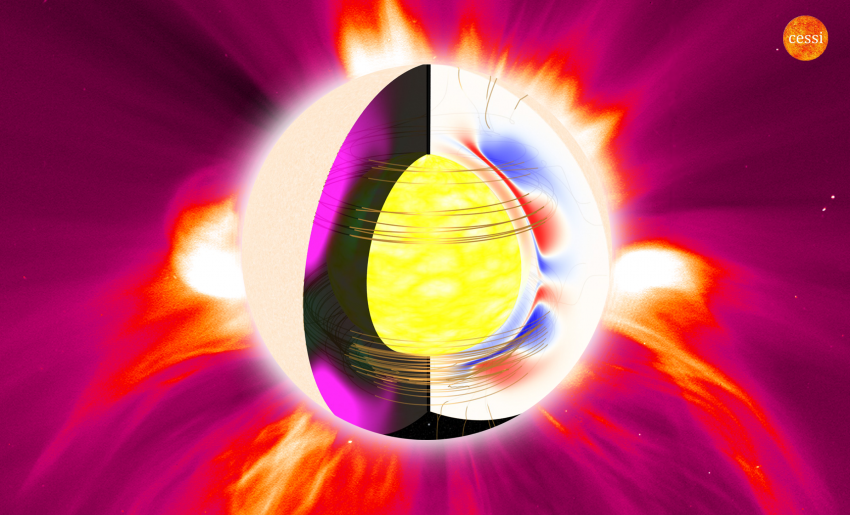According to a new study, middle-aged stars can undergo a midlife crisis of their own kind, experiencing drastic interruptions in their activity and rotation rates at about the same age as the Sun.
 Artist’s impression of the spinning interior of a star, generating the stellar magnetic field. This image combines a dynamo simulation of the Sun’s interior with observations of the Sun’s outer atmosphere, where storms and plasma winds are generated. Image Credit: CESSI / IISER Kolkata / NASA-SVS / ESA / SOHO-LASCO.
Artist’s impression of the spinning interior of a star, generating the stellar magnetic field. This image combines a dynamo simulation of the Sun’s interior with observations of the Sun’s outer atmosphere, where storms and plasma winds are generated. Image Credit: CESSI / IISER Kolkata / NASA-SVS / ESA / SOHO-LASCO.
The study, which was recently reported in the journal Monthly Notices of the Royal Astronomical Society: Letters, offers a new theoretical foundation for the unexplored collapse of established methods for quantifying ages of stars past their middle age, and the shift of solar-like stars to a magnetically inactive future.
For a long time, astronomers have been well aware that stars tend to experience a process called “magnetic braking.” In this process, a constant stream of charged particles, called the solar wind, escapes from the star over the years, taking away small amounts of the star’s angular momentum. This gradual drain is responsible for stars like the Sun to slowly retard their rotation over billions of years.
The slower rotation results in modified magnetic fields and less stellar activity — the numbers of flares, sunspots, outbursts and related phenomena in the atmospheres of stars, which are closely associated with the strengths of their magnetic fields.
This decline in activity and rotation rate with time is estimated to be smooth and predictable due to the gradual loss of angular momentum. The concept brought forth the tool called “stellar gyrochronology.” This tool has been extensively employed in the last 20 years to calculate a star’s age from its rotation period.
Yet, new observations suggest that this close relationship falls apart around middle age. The recent study performed by Bindesh Tripathi, Professor Dibyendu Nandy, and Professor Soumitro Banerjee at the Indian Institute of Science Education and Research (IISER) Kolkata comes up with a new explanation for this confusing ailment.
The researchers employed dynamo models of magnetic field generation in stars and showed that at around the age of the Sun, the magnetic field generation mechanism of stars abruptly turns less efficient or sub-critical.
The survival of the stars is thus enabled in two different activity states: a low activity mode and an active mode. A middle-aged star similar to the Sun can frequently switch to the low activity mode, leading to considerably decreased angular momentum losses due to magnetized stellar winds.
This hypothesis of sub-critical magnetic dynamos of solar-like stars provides a self-consistent, unifying physical basis for a diversity of solar-stellar phenomena, such as why stars beyond their midlife do not spin down as fast as in their youth, the breakdown of stellar gyrochronology relations, and recent findings suggesting that the Sun may be transitioning to a magnetically inactive future.
Dibyendu Nandy, Professor, Center of Excellence in Space Sciences India and Department of Physical Sciences, Indian Institute of Science Education and Research
The new study offers a better understanding of the presence of low activity episodes in the recent history of the Sun called grand minima, when sunspots are hardly noted. The best known of these is probably the Maunder Minimum, which happened around 1645 to 1715 when very few sunspots were seen.
The researchers believe that these studies will provide insights on recent observations denoting that the Sun is relatively inactive, with crucial impacts for the possible long-term future of the stellar neighbor.